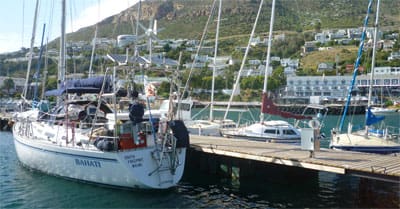On our circumnavigation aboard our Montevideo 43, Bahati, we found there were four particularly tricky passages. The most challenging passages were: 1) in and out of New England, 2) in and out of New Zealand, 3) up and down the Strait of Malacca (connecting Malaysia and the Indonesian archipelago), and, finally, 4) the stretch of water known as the “Wild Coast” connecting Durban and Port Elizabeth and onward to Cape Town, South Africa.
The NZ passages are, measured solely in miles, the longest. All four passages require careful planning and moment-to-moment close attention paid to whatever weather forecasting instruments you have on hand. In this piece I will focus on the last two: The Strait of Malacca and the passage along South Africa’s Indian Ocean coast.
The Strait of Malacca
When Bahati sailed north out of Puteri, Malaysia, toward Thailand I was alone aboard. I am primarily a social being and like sailing in the company of friends best, but when I found myself stuck in Johor without any onward crew easily available I thought, “This is a good chance to test my solo sailing skills. It’s not that far up to Langkawi, why not??”
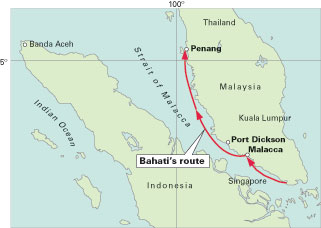 |
|
Warren-White’s route through the Strait of Malacca. |
The first day went fine. Not much wind, but I was able to motor-sail clear of Singapore Strait and its ubiquitous thicket of shipping. At one point the AIS unit showed more than 200 vessels within less than 20 nm. The visibility was pretty good to start with and I was able to hug the east side of the channel and avoid most oncoming and overtaking traffic, but I had to remain constantly vigilant. The sense of independence felt great! I could sing, dance, go naked, do whatever/whenever I felt like it.
The Strait of Malacca is officially defined as the narrow stretch of water flowing between the Malay Peninsula and the Indonesian island of Sumatra. The total length is only 805 km, but it remains the main shipping channel between the Indian and Pacific oceans. More than 50,000 vessels pass through the Strait each year carrying about a quarter of the world’s traded goods. Needless to say, it’s a hectic place.
Piracy down, but not out
Ten years ago, piracy in the Strait was on the rise, with more than 150 incidents reported in 2004. Shortly after that the Malaysian, Indonesian, and Singapore navies increased patrols in the region and attacks dropped to 79 in 2005 and 50 in 2006. As of November 2012, only two incidents had been reported for that year and none between 2009 and 2012. This is good news. Nonetheless, piracy remains a concern. I had chosen not to carry a weapon (other than my flare gun) because, if it came to it, I did not want to get into a fire fight with folks who were bound to be both more ruthless and better shots than I am.
There are also 34 shipwrecks scattered along the Traffic Separation Scheme (TSS) which is the channel one must follow to avoid non-moving dangers.
Then there is the haze caused by raging bush fires along the shoreline. These fires can quickly reduce visibility to less than 200 meters. Ships longer than 1,150 feet typically pass through the Strait and it takes a long time to slow down or turn a ship of that size. Needless to say, when sailing a 43-foot boat it’s up to me to stay out of the Big Boys’ way. The good news is that between radar and AIS, I was able to “see” 80 percent of the vessels in my path long before I could actually eyeball them.
There are also hundreds of smaller vessels out there: fishing craft, pleasure craft, pirate vessels, military patrol boats, you name it. Most will not be broadcasting or receiving AIS. (In the case of the pirates and the military, they might well, like us, be receiving but not sending!)
Intense weather
Then there’s the weather. Along the north coast of Sumatra the SW monsoon prevails from April to November and the NE monsoon blows the rest of the year. During the SW monsoon the winds typically hold night and day, but when the NE monsoon kicks in winds tend to disappear around sunset. Winds are, at best, somewhat fickle and unpredictable. Also, because the Strait is so narrow and there are winds coming from different directions as well as large temperature variations, this area is often a “weather breeder.” Water spouts and intense thunder and lightning storms are common.
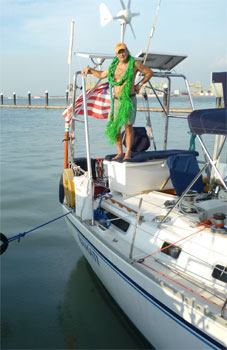 |
|
The author shows off the heavy line he cut from Bahati’s prop shaft. |
As you can surmise, with this combination of weather, shipping, tight navigation, fishing, and possible piracy, this is a stretch of water that can become tricky in a hurry.
I managed to find my way to Admiralty Marina, Port Dickson, about two day’s run north of Singapore. I’d had one night at sea by myself (yeah!) and it was a relief to pull into this inviting and hospitable upscale Malaysian harbor and find both friendly dock hands and a lovely pool with adjoining simple but elegant eatery awaiting me. I found myself practically alone there…and the food was good!
Two days later, I left Port Dickson early in order to get as far north as possible before nightfall. My plan was to reach the island of Penang, 235 nm north, at the end of the next day. By late afternoon, the wind had picked-up to Force 5 and the skies to the west were black. Here’s what I later wrote on my blog:
“The most nerve-wracking part of this passage were the lightning storms that plagued me primarily between Port Dickson and Penang, along the narrowest and trickiest part of the Strait. The lightning began toward dusk and carried on for several hours till near midnight and then again returned at dawn. Much of it was the cloud to water variety, which really gives one pause…nearly blinding and horrendously violent. I kept wondering when I would take a direct hit. Not much sleep garnered for those 48 hours, but fortunately we escaped unscathed. I thank the sea gods for their mercy!”
Most frightening night
In all truth, the first night of that solo passage was easily the most frightening experience I had, alone or otherwise, on the entire voyage. During the worst of it, I hove-to, checked the radar and then unplugged all the electrics, placed one plotter and a handheld VHF in the microwave for protection, and then plunked myself holding my breath in the forward head being careful not to touch any metal surface. The deluge went on for more than four hours. At several points I stuck my head out of the companionway and did a 360° scan. I could see nothing! We were in white-out conditions with torrential downpour interspersed with a wild lightning show and accompanying “sturm und drang.” In one frightening moment, a Malaysian fishing boat chugged out of the loom and passed me going in the opposite direction less than 50 feet away. Too close for comfort!
Eventually, of course, things settled down and I was able to get a little shut-eye. But then it kicked-up again at dawn! And the same pattern repeated itself the next day. I was relieved when Penang finally hove into view. With great fatigue and slowly deepening breath, I found my way into the trash-filled marina and tied-up to a badly damaged floating concrete dock wide-open to the nearby ferry pier. I hung out every bumper I could find and strung a couple of extra lines across to the empty dock next-door and then hit my bunk and slept…for eight hours. The disco “music” blasting from the next pier ran late into the night. It sounded like heaven to my ears after Mother Nature’s onslaught.
I left Penang and, without further trouble, found my way 70 nm north to Langkawi where I spent a couple of idyllic days rock climbing and diving on the bizarre limestone formations with our good friends aboard the Norwegian sloop Empire. I’d survived my first solo passage and I did not feel the need to repeat the act.
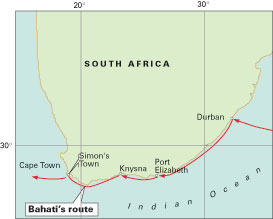 |
|
Warren-White made landfall at Durban then sailed coastwise to Simon’s Town. |
As things evolved, a few months later, I was back in Langkawi alone aboard Bahati again. Fortunately, I discovered that my friend Boomerang Bob from Houston was heading in the same direction aboard his custom-built 47-foot steel sloop. We agreed to “buddy-up.”
Engine mishap
We set off motor-sailing with a light southerly breeze early on the morning of July 5th. We had traveled less than 10 miles en route toward Penang when my trusty Yanmar suddenly lugged down and coughed to a stop. I immediately guessed I’d picked something up on the prop and called Bob on the VHF to tell him what was happening. He circled back around and hovered nearby while I donned mask and flippers and jumped over the side. Within seconds, I could see the large piece of a three-inch bright green polypro hawser wrapped around the shaft and prop. Fortunately, it took only two dives to untangle it. I threw it on the aft-deck like a trophy fish. With no further problems we landed back in mysterious garbage-strewn Penang.
The rest of the passage was smooth and we encountered none of the bad lightning storms I recalled with such clarity. Our last night out, with an estimated single day’s run left to reach Puteri, we pulled into the lee of a small island where there appeared to be reasonable protection…as long as the wind did not shift around during the night. The weather forecast warned there might be thunderstorms the next day, but it sounded like they’d hold off till after we got underway. Of course, Murphy was bound to raise his laughing head as soon as we allowed ourselves to relax.
Just before dawn I awoke sensing that something had changed. Bahati was pulling at her anchor awkwardly and I could hear the wind picking up. I stuck my head out of the aft hatch and immediately saw that the sky was darkening to the west. The air felt charged. I could see Boomerang’s anchor light just to windward. I realized the wind had come round 180 degrees putting me dangerously close to the lee shore. My depth sounder said I had 20 feet under the keel, but I couldn’t be sure how fast it might shoal-up as we stretched back on the chain in the approaching squalls.
As I was getting underway I looked ahead and saw a small fishing vessel slowly crossing my bow. He was at least a quarter mile from me and I was not worried about getting too close. As I started crossing his stern a bright light suddenly flashed from his wheelhouse and I realized with horror that he was probably purse-seining. If so, his gear would be just about under my boat. Before I could reach the gear shift I felt the engine lug down and within seconds the prop seized and we were dead in our tracks. It was déjà vu all over again only this time the situation was compounded by the weather.
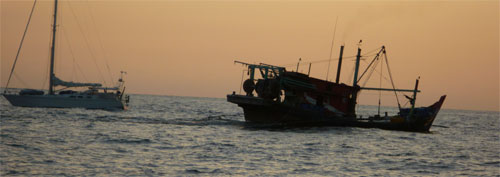
A Malaysian fishing vessel and a fellow voyager’s boat Boomerang,
a 47-foot custom steel sloop, pass in the strait near sunset.
Snagged sideways
Within minutes I felt Bahati moving weirdly sideways. I quickly realized we were being reeled in like a dead fish. I watched helplessly as we were hauled within 50 feet of the fishing vessel. I grabbed the sharp knife I kept strapped to the arch for emergencies and gestured to the clearly angry captain that I was going to jump overboard and start cutting. He yelled at me in Bahasa to do no such thing and proceeded to push his young crew over the side. I could see instantly that the boy was a not a good swimmer and feared I might easily have a drowning kid on my hands in addition to an angry fisherman. I tried to urge the boy to climb to safety aboard Bahati, but as he started to reach for the ladder his boss shouted at him and the next thing I knew the scared kid was trying to dive under the boat.
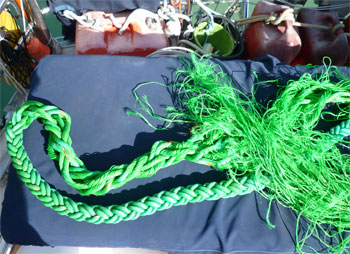 |
|
The three-inch polypro hawser required several dives to remove from Bahati’s prop and prop shaft. |
It was hopeless. The lines were wrapped like a rat’s nest around the prop and shaft. Some of them looked like they’d hung-up on my zincs and rudder too. Desperately, with my head slamming against the bottom of the boat, I started cutting. The kid was sputtering and struggling to stay afloat. Finally, I was able to push him aboard Bahati and for some reason his mad captain stopped shouting. It was in that moment that I recognized how exhausted I’d become. I climbed aboard, shared some water with the kid, took a deep breath and jumped back in. More than a dozen dives later, trying to keep from cutting myself with my own knife or running into the razor sharp prop spur, I was finally able to get the web cleared enough to break free. I helped the kid back onto his own boat and started the engine. Before pulling away, I jumped below and stuffed two cans of Coke and the equivalent of $100 in Malaysian currency into a Ziploc bag which I tossed to the kid with a shout of thanks. I watched as they immediately began to set their gear again. I felt completely drained and dehydrated as we aimed south and the rain and wind hit us hard. For the first time I noticed my right ankle bleeding.
The squalls lasted most of the morning, but by the time we approached the Singapore/Jahor ship channel the sun was shining and we were tied up safely back at Puteri by day’s end. I developed an infection that took three rounds of antibiotics to get under control. Tough but valuable life lessons learned. As my dad always told me, “Stay vigilant and expect the unexpected!” Also, in the wise words of Sophocles: “The greatest griefs are those we cause ourselves.”
The ‘Wild Coast’ of South Africa
The day before we left Durban to sail south down the “Wild Coast” toward Port Elizabeth, the first safe harbor available on the rough route to Cape Town, I visited the local marine hardware store to pick up a few bits and pieces. As I was settling-up with the owner, a remarkable photo perched on the shelf behind his desk caught my attention. It showed a 40-something-foot sailing vessel sitting atop a sheer cliff a couple of hundred feet above a raging sea.
The shop owner laughed when I ask about it. “Hah, mate…that’s a real picture taken during the race between Durban and Cape Town. I was the navigator on that boat!” He quickly explained that this “beaching” was the result of the enormous seas created when the strong winds out of the SE, known as “Buster,” turn against the fast southwesterly driving Agulhas Current which can reach speeds of up to six knots or more. Steep waves as high as 60 feet have been recorded here. Needless to say, it’s crucial to time your passages along this stretch of empty coastline carefully. Fortunately, there are numerous weather forecasts readily available and local sailors like Tony Herrick of Cruising Connections (www.cruisingconnections.co.za) are more than willing to offer support and advice to visiting yachts.
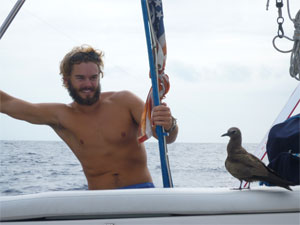 |
|
Warren-White’s shipmate Ben Powers and a South African hitchhiker. |
Surfing past a ship
Bahati arrived in Durban on Nov. 20 surfing through the breakwater with 30- to 40-knot winds behind us. I was fortunate to have Ben Powers aboard for the run from Bali to South Africa. Ben is an extremely capable young sailor and a gentle soul who came to me through a mutual friend. We had only spoken briefly on the phone and both felt lucky to share a similar need for solitude. We learned to trust each other implicitly during the long and rough run across the Indian Ocean. Ben was at the helm as we flew into Durban Harbor at 1400. We had spoken to Durban Port Control via VHF to let them know we were on our way in, “ready or not.” As we rode the breaking waves past the entrance they responded, asking us to proceed with caution as a cargo vessel was headed out at the same moment. We could not have stopped if we’d wanted to. I looked at Ben as we got the word and asked, “Are you okay?” He nodded, gripping the wheel tighter, and we hung on as we shot around the corner just as the merchant vessel appeared. We passed port to port less than 300 feet from each other. We’d arrived! As we approached the Royal Natal Yacht Club under police escort our lines were taken by a local sailor who shouted: “I know this boat! A Monte! Used to be called Whisper didn’t she?!” Bahati was built in 1988 in Cape Town. After 20 years, it was welcome home time!
We departed Durban only four days after arriving because we were presented with a weather window that we thought could get us at least as far as Port Elizabeth. We soon discovered that the local weather reports can be as much as 12 hours late in their forecasting. Almost without fail the bad stuff hit us just shy of our next safe port. We quickly learned that sailing in winds of Force 7-10 is standard fare along this coast with the Southern Ocean constantly sneezing on the local fleet. With the Agulhas Current pushing from behind our log hit an all time high of 17.6 knots at 0200 on the morning of Nov. 26, the fastest we’ve ever seen Bahati go. This was also the only place we ever saw seals sailing. They lie on their backs with their long flippers raised high in the air catching the breeze and floating downwind. In the midst of the current, we also saw a great white shark passing us less than a boat length to windward. Without question this was the most exhilarating sailing either of us had ever experienced.
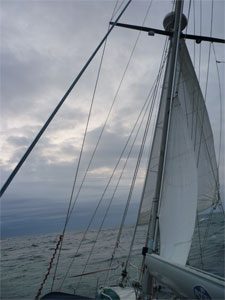 |
|
Shortened sail on the South African coast. |
We’d been lucky to meet a couple of local South Africans in Mauritius just finishing their own pre-nuptial three-year circumnavigation aboard the 38-foot sloop uMoya. They kindly shared a digital copy of Tony Herrick’s excellent Southern Africa Cruising Notes. We visited Tony in his shop on Fenton Lane in Durban just around the corner from the chandlery where I’d seen the cliff-top yacht photo. He was most welcoming even offering to be our weather guru as we sailed south. We called him daily at 1100 for the latest lowdown. We found his advice right on the money (though he refused to take any payment for it!)
Rock strewn entrance
By luck, we timed our arrival in Knysna, the only truly natural lagoon along this stretch of coast, perfectly. Tony’s e-book warned us that we needed to get there on a rising tide with no wind in order to avoid being shipwrecked in the dangerous narrow and rock-strewn entrance between the towering Knysna Heads. We’d been told we could try and hail the local harbor master, Herbie Mob, as we made our approach. Herbie gave us the “all-clear” and at 0600 we surfed gently through the narrow entrance with humpbacks breaching in our wake and the sound of the vuvuzela calling us from atop the 200-foot cliffs. Our South African crewmember from three years earlier, Gareth Weiss, welcomed us with his now 1-year-old daughter, Maya, in his arms and his wife, Ana, by his side. We’d first met them in Antigua in 2006. What a joyful reunion!
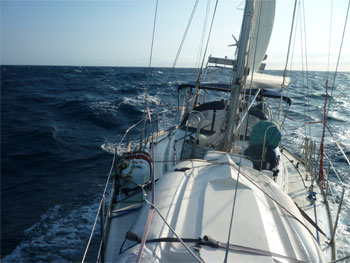 |
|
Bahati experiencing the brisk winds along the South African coast. |
Two weeks later we safely rounded Cape Agulhas, the actual southern-most point of Africa. On Dec. 10, arriving earlier than expected due to 40 knots of breeze and a strong favorable current, we arrived safely in Simon’s Town. We hove-to in Pringle Bay behind Cape Hangklip on the north side of False Bay for several hours to avoid being snared by the dense fog hanging over Table Mountain. Again, with our hearts in our mouths, we surfed round the breakwater with gusts up to 50 knots, but with willing hands from fellow cruisers waiting to take our lines.
We dubbed False Bay Yacht Club the most welcoming and kindest of hosts since leaving the Opua Cruising Club in the Bay of Islands, New Zealand two years earlier. With the able help of the local marina crew we hauled Bahati on a traditional ways and did our last bottom job before arriving home in Maine. We removed organic growth from the shaft and zincs that looked like prehistoric macaroni and replaced both a cutlass bearing and the stuffing box after several years of heavy use.
The byword for this tricky passage is to proceed with caution, heed the local knowledge, and be prepared for the ride of a lifetime.
————
Nat Warren-White has found his way with his 1st mate and wife, Betsy, home to Maine. He is working as a management consultant while scheming his next voyage…possibly to Norway and then west-about South America.

